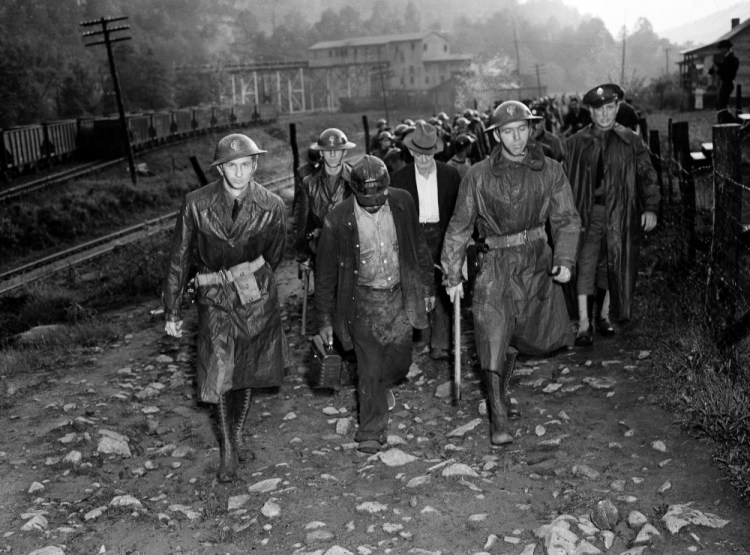HARLAN, Ky. — Kentucky coal miners bled and died to unionize.
Their workplaces became war zones, and gun battles once punctuated union protests. In past decades, organizers have been beaten, stabbed and shot while seeking better pay and safer conditions deep underground.
But more recently the United Mine Workers in Kentucky have been in retreat, dwindling like the black seams of coal in the Appalachian mountains.
And now the last union mine in Kentucky has been shut down.
“A lot of people right now who don’t know what the (union) stands for is getting good wages and benefits because of the sacrifice that we made,” said Kenny Johnson, a retired union miner who was arrested during the Brookside strike in Harlan County in the 1970s. “Because when we went on those long strikes, it wasn’t because we wanted to be out of work.”
Hard-fought gains are taken for granted by younger workers who earn high wages now, leading the coal industry to argue that the union ultimately rendered itself obsolete. But union leaders and retirees counter that anti-union operators, tightening environmental regulations and a turbulent coal market hastened the union’s demise in Kentucky.
The union era’s death knell sounded in Kentucky on New Year’s Eve, when Patriot Coal announced the closing of its Highland Mine. The underground mine in western Kentucky employed about 400 hourly workers represented by the United Mine Workers of America.
For the first time in about a century, in the state that was home to the gun battles of “Bloody Harlan,” not a single working miner belongs to a union. That has left a bad taste in the mouths of retirees: men like Charles Dixon, who heard the sputter of machine gun fire and bullets piercing his trailer in Pike County during a long strike with the A.T. Massey Coal Company in 1984 and 1985.
“I had my house shot up during that strike,” said Dixon, the United Mine Workers local president at the time.

Coal miners return on a buggy after working a shift underground at the Perkins Branch Coal Mine in Cumberland, Ky., on Oct. 15, 2014, The Associated Press
DEADLY BATTLES
The shots fired at Dixon’s home recall the even deadlier organizing battles of the 1920s and ’30s, many in Harlan County.
One ambush shooting in 1937 ended with the death of union organizer Marshall Musick’s 14-year-old son, Bennett, when “a shower of bullets tore through the walls of the house,” according to union leader George Titler’s book, “Hell in Harlan.”
Organizing battles raged in Appalachia throughout the last century, most notably the 1921 Battle of Blair Mountain in West Virginia, where thousands of striking miners fought a shooting war with law enforcement and replacement workers, ending in dozens of deaths. One year earlier, 10 people had died in Matewan, West Virginia, in a skirmish over eviction notices served to miners who had joined the union.
PICKET LINE DANGERS
Johnson, who appeared in the film when he was 22 years old, returned this summer to the scene of his first picket line arrest along state Highway 38 in Harlan County.
He had stood there, near the Highsplint mine entrance, with other union members and gasped as state troopers set up a machine gun across the street. After about four hours of noisy picketing, a tall trooper stuck a baton between Johnson’s legs and raised it up to his groin.
“We just came to lend them a hand that day, and ended up going to jail,” said Johnson, now 63 and battling health issues.
Johnson, Dixon and union leaders worry that the union’s disappearance in Kentucky has opened the door for coal operators to lower worker standards.
“When the coal industry rebounds to the extent that it does, and non-union operators take a look around and see that there’s no union competition, and they’ll see that they can begin to cut wages, they can begin to cut benefits, they can begin to cut corners on safety, they’ll do that,” said Phil Smith, a national spokesman for the miner’s union.
Smith pointed to operations run by former Massey Energy chief Don Blankenship, who closed union mines in the 1980s and now faces criminal conspiracy charges in the 2010 deadly explosion at the Upper Big Branch mine in West Virginia that killed 29 workers.
But industry leaders argue that higher wages and safer mines in recent decades have reduced the desire for workers at non-union mines to organize.
“Anymore, I just don’t think there’s that level of discontent between the company and working coal miners, which I think is a very good thing,” said Bill Bissett, president of the Kentucky Coal Association, an industry group.
Bissett said mines have become safer despite the union’s diminished presence in Kentucky. “We’re in some of the safest time in the history of U.S. mining right now and a time when the UMWA is at their lowest level,” he said.
Send questions/comments to the editors.



Success. Please wait for the page to reload. If the page does not reload within 5 seconds, please refresh the page.
Enter your email and password to access comments.
Hi, to comment on stories you must . This profile is in addition to your subscription and website login.
Already have a commenting profile? .
Invalid username/password.
Please check your email to confirm and complete your registration.
Only subscribers are eligible to post comments. Please subscribe or login first for digital access. Here’s why.
Use the form below to reset your password. When you've submitted your account email, we will send an email with a reset code.